|
SABER TOOTHED HERRING
Enchodus (Agassiz 1843)
Age Cretaceous to Paleocene? - Occurrence Abundant
E. petrosus (Cope, 1874)
E. ferox (Leidy, 1855)
E. gladiolus (Cope, 1872)
The fossil remains of the
Enchodus spp. found in New Jersey are usually limited to isolated
teeth, dermopalatines, and jaw fragments. Two species of Enchodus
are commonly found in New Jersey E. petrosus and E.
gladiolus. E. ferox is rare but recent studies
indicate this species may have survived into the Paleocene and is worth
noting.
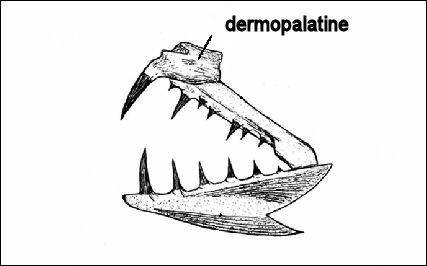
Enchodus
spp.
Characteristics (based on Goody, 1976; Fielitz, 1999b).
|
Tooth Characteristics |
E.
petrosus |
E.
ferox |
E.
gladiolus |
|
General tooth form |
Straight |
Straight |
Slightly sigmoidal, more laterally compressed |
|
Tooth striations |
Internal surface coarsely
Striated - Outer surface
smooth |
Inner/outer surface smooth to faintly
striated |
Both surfaces smooth to
very finely striated |
|
Presence/Absence of a
post-apical barb |
No |
No |
Yes |
|
Number and position of
carinae on palatine tooth |
2 full length placed
anteriorly and laterally |
2 full length placed
anteriorly and laterally |
1 anterior, full length |
|
Presence/Absence of
serrations on carinae |
No |
Yes |
No |
|
|
|
|
|
A highly simplified table of the palatine teeth characteristics.
E.
ferox is rare and will only briefly be mentioned at the end.
E. petrosus
and E. gladiolus
palatine teeth
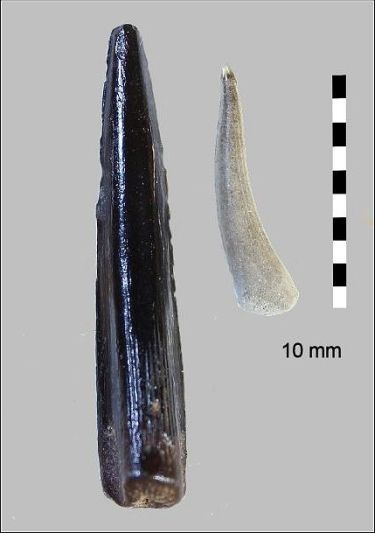
Left - E. petrosus Right - E. gladiolus
There is a marked difference in the teeth of these two species, E.
petrosus
is the larger of the two species but normally I just look at
the general tooth shape
and for the distinctive barb on E. gladiolus.
Commonality may depend on your collecting methods, I have more
examples
of E. gladiolus in my collection but this may be the result of
using a finer mesh second
screen in collecting. The teeth of E. petrosus also tend to have
little or no enamel and I
don't keep these.
Enchodus petrosus
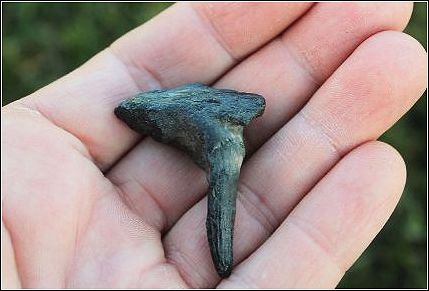
Enchodus petrosus dermopalatine with intact
tooth.
Dermopalatine fragments are common, finding these with the palatine
tooth
intact is a bit more difficult. The size and presence of two cutting
edges makes
this easy to id.
Basal Navesink Monmouth County, NJ
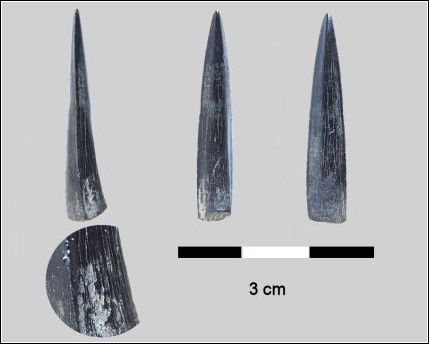
Plate 1
Enchodus petrosus
Profile, inside, outside and close-up of striations.
Enchodus gladiolus
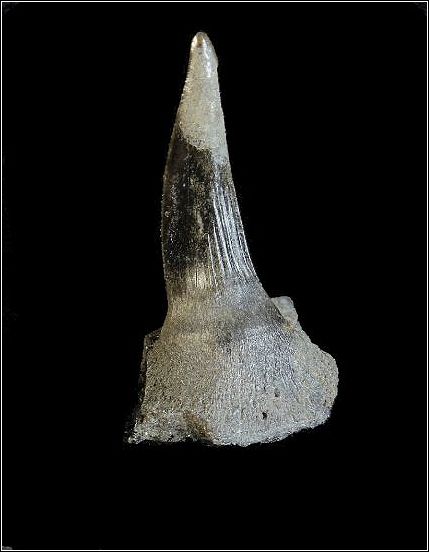
Enchodus gladiolus
A beautiful specimen.
Monmouth County, New Jersey
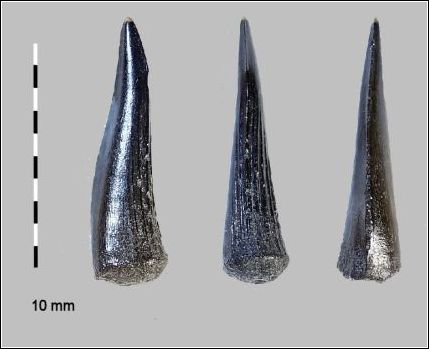
Plate 2
Enchodus gladiolus
Left to right
Profile -
sigmoidal shape and barb
Inner - striations
Anterior - single cutting edge
Additional photographs
Top Left - Enchodus petrosus dermopalatines
Top Right - Large dermopalatine fragment of E. petrosus
Bottom Left - Large stream worn Enchodus petrosus tooth
Bottom Right -Jaw fragment, species unknown
Enchodus ferox
E. Ferox is similar
to E. petrosus except it is smaller and the
carinae
serrated. I've
only found a single tooth although this could be the result of where I
collect. E. Ferox is known
from the Paleocene in Europe and the same is suspected in North America
but as of yet, the few specimens that are purportedly from Paleocene
sediments are very questionable.
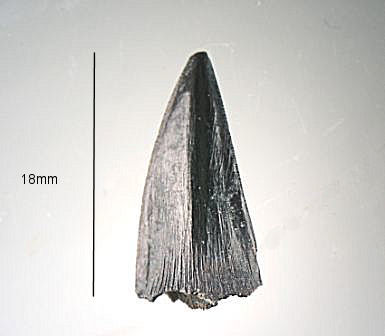
Lateral E. Ferox identified by Dave Parris from
the New Jersey
State Museum.
Found at Inversand, it's impossible to be sure of the exact formation.
Selected References
Goody, P.C., 1976, Enchodus (Teleostei: Enchodontidae)
from the Upper Cretaceous
Pierre Shale of Wyoming and South Dakota with an evaluation of
North American enchodontid species: Palaeontographica, v. 152, p.
91–112.
Schein, J.P., 2004, The teleost fish Enchodus and the paleoceanography
of Upper
Cretaceous rock units in Alabama [M.S. thesis]: Auburn, Alabama, Auburn
University, 156 p.
Fielitz, C., 1999, Phylogenetic analysis of the family Enchodontidae and
its relationship
to Recent members of the order Aulopiformes [Ph.D. thesis]:
Lawrence, University of Kansas, 86 p.
Return to top of page
|